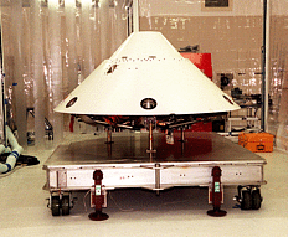The Mars Polar Lander was lost on December 3, 1999.
Click on image for full size
Courtesy of NASA
Still Looking for Lander
News story originally written on January 10, 2000
Scientists still don't know what caused the Mars Polar Lander to fail, but they aren't ruling out a deep canyon near the landing site.
A recent article in the Post suggested scientists didn't know the canyone existed, but leaders of the project say that's not true.
This huge 'hole' is 30 X 8 miles and has steep slopes that may have caused the craft to fall over.
Still, scientists say it was the safest possible landing site. Strong winds of 75 miles per hour would be necessary from the surface to 30 miles in altitude
for the spacecraft to be blown into the pit. Scientists are not ruling this out, but they believe it is more likely there was a failure aboard the craft.
The Mars Surveyor is mapping the area near the landing site, looking for any evidence. Until then, leaders of the mission are taking the blame.
You might also be interested in:

Just when everyone had given up hope, a faint signal was received at Stanford University. Scientists say it most likely came from Mars, although they won't know for sure until later this week. The signals
...more
It was another exciting and frustrating year for the space science program. It seemed that every step forward led to one backwards. Either way, NASA led the way to a great century of discovery. Unfortunately,
...more
The Space Shuttle Discovery lifted off from Kennedy Space Center on October 29th at 2:19 p.m. EST. The weather was great as Discovery took 8 1/2 minutes to reach orbit. This was the United States' 123rd
...more
A moon was discovered orbiting the asteroid, Eugenia. This is only the second time in history that a satellite has been seen circling an asteroid. A special mirror allowed scientists to find the moon
...more
Will Russia ever put the service module for the International Space Station in space? NASA officials want an answer from the Russian government. The necessary service module is currently waiting to be
...more
A coronal mass ejection (CME) happened on the Sun early last month. The material that was thrown out from this explosion passed the ACE spacecraft. The SWICS instrument on ACE has produced a new and very
...more
J.S. Maini of the Canadian Forest Service called forests the "heart and lungs of the world." This is because forests filter air and water pollution, absorb carbon dioxide, release oxygen, and maintain
...more














